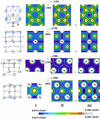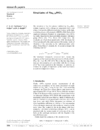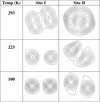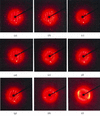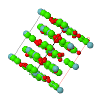issue contents
October 2003 issue

Cover illustration: Orange polytypically disordered crystals of HgI2 are built from layers of corner-linked Hg4I10 supertetrahedra. The stacking disorder has been quantitatively analyzed with a Markov chain model. Two probabilities describing next-nearest-layer interactions were adjusted to observed diffuse intensity profiles extracted from image-plate detector data. Results show nearly equal volumes of the two maximum degree of order structures, with an average domain thickness of about 5 layers or 30 Å [Hostettler, Birkedal & Schwarzenbach (2002), Acta Cryst. B58, 903-913].
research papers
A total of 16 new structures reported in the ICSD under space groups P31 and P32, of which six have two or more isostructural entries, satisfy the structural criteria for ferroelectricity. Three new members of the ferroelectric stillwellite family satisfy the structural criteria, ten structures are dubious or incorrect, one is probably pyroelectric, but is unlikely to become ferroelectric, and three others are either incompletely solved or incompletely refined.
Download citation


Download citation


Calorimetric and dielectric properties are correlated with structure in each of the five phases formed by Pb5Al3F19. Maximum atomic displacements range from 1.21 (6) Å at the lowest- to 0.7 (4) Å at the highest-temperature phase transition. The introduction of 3d electrons into the lattice disturbs the equilibria that stabilize the three intermediate phases.
Features of the atomic interactions in MgB2 are considered using the multipole-model electron density reconstructed from a room-temperature single-crystal X-ray diffraction experiment. These features are compared with theoretical calculations performed by tight-binding linear muffin-tin orbital (TB-LMTO) and full-potential non-orthogonal local orbital (FPLO) methods.
Download citation


Download citation


The structures of the four phases of the tungsten bronze NaxWO3 have been determined using the high-resolution powder diffractometer (HRPD), ISIS, Rutherford Appleton Laboratory, England. At low temperatures the octahedra are tilted; in Glazer's notation the structures follow the sequence a+a+a+, a+a+a0, a0a0c+, a0a0a0 with increasing temperature. This is the first time the structure of a phase with two plus tilts has been reported.
Download citation


Download citation


Crystals of germanium-doped RbTiOPO4 have been characterized by X-ray diffraction and dielectric measurements. A direct correlation between the room-temperature split positions of the rubidium cations and the phase-transition temperature (Tc) has been discovered. General trends regarding the relationship between the room-temperature structures of KTP-like compounds and their Tc values are discussed.
Download citation


Download citation


The structure of sodium percarbonate, Na2CO3·1.5H2O2, has been determined at temperatures between 293 and 100 K. As the temperature drops, hydrogen peroxide becomes ordered, and a phase change takes place at 240 K when the room-temperature space group, Cmca, is replaced by Pbca.
Download citation


Download citation


Single-crystal X-ray diffraction on a series of M0.5Bi3P2O10 compounds with M = Ca, Sr, Ba, Pb shows that they are isostructural with Bi6.67P4O20. Infinite Bi2O2 chains are interconnected via polyhedra with sandwiched phosphate tetrahedra.
Download citation


Download citation


The crystal structures of the orthomolybdates NaFe4(MoO4)5, α- and β-NaFe2(MoO4)3 and Na3Fe2(MoO4)3 are described and compared with each other and other related structures.
Download citation


Download citation


Temperature-resolved structural `snap-shots' of the title compound have been determined, showing molecular mobility details in the pathway to the liquid crystal discotic mesophase. DSC measurements corroborate the fact that an intermediate transition to a less well ordered crystalline form takes place at 326 K.
Download citation


Download citation


The low-temperature phase of [(CH )
) N](ClO
N](ClO ) is solved. A phase transition is produced by the electrostatic interactions of the ClO
) is solved. A phase transition is produced by the electrostatic interactions of the ClO
 ions, thus giving orientational domains with varying population.
ions, thus giving orientational domains with varying population.
CSDSymmetry, a database that brings together information concerning molecular and crystallographic symmetry, has been used to probe relationships between the symmetry of occupied Wyckoff positions and the molecules they accommodate.
Download citation


Download citation


A comparison of the structures presented here with similar structures shows how the effects of change in composition and sometimes chirality can be accommodated with minor adjustments in essentially the same aggregation pattern and molecular conformation.
Strain broadening of the powder diffraction peaks from L-alanine doping in triglycerine sulfate (LATGS) is analyzed using Williamson–Hall methods for peak-profile analysis. The results show that L-alanine doping in TGS leads to anisotropic strain broadening of the powder peaks.
Download citation


Download citation


A neutron diffraction study of xylitol is presented and estimates of the internal mean-square displacements of the H atoms obtained by subtraction of a rigid-body model from the total H-atom mean-square displacements are given. The result is compared with similar analyses of 12 other neutron diffraction studies found in the literature.
Download citation


Download citation


Analyses of short contacts in 4,4′-bipyridin-1,1′-ium dichloride, 4,4′-bipyridin-1,1′-ium dinitrate and 4,4′-bipyridin-1-ium bromide monohydrate show that supramolecular aggregation in these complexes is dominated by discrete bipyridinium cations and anions. These ions form chains stabilized by various interactions in a three-dimensional framework.
Download citation


Download citation


The behaviour of the substrate and the product molecules during a topotactic photodimerization reaction was monitored by X-ray diffraction.
Multilinear-regression analyses between the molecular structures of 226 organic compounds and their enthalpies of sublimation are analysed. A predictive model of enthalpy of sublimation is tested on a 35-compound validation data set.


 journal menu
journal menu













